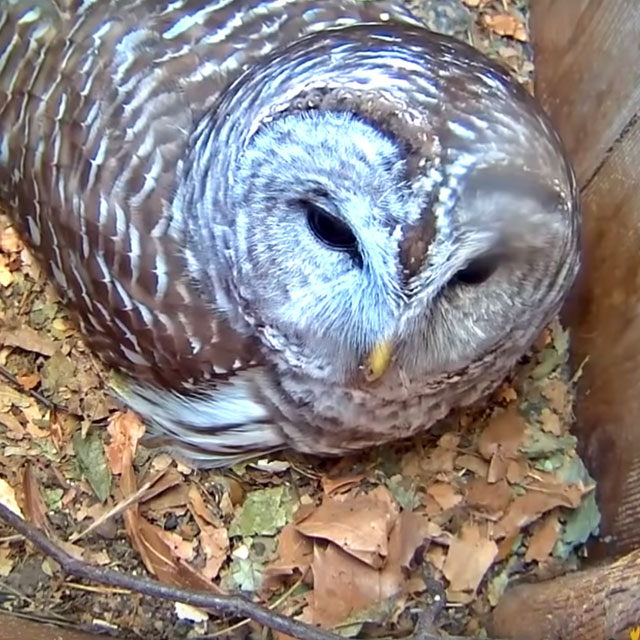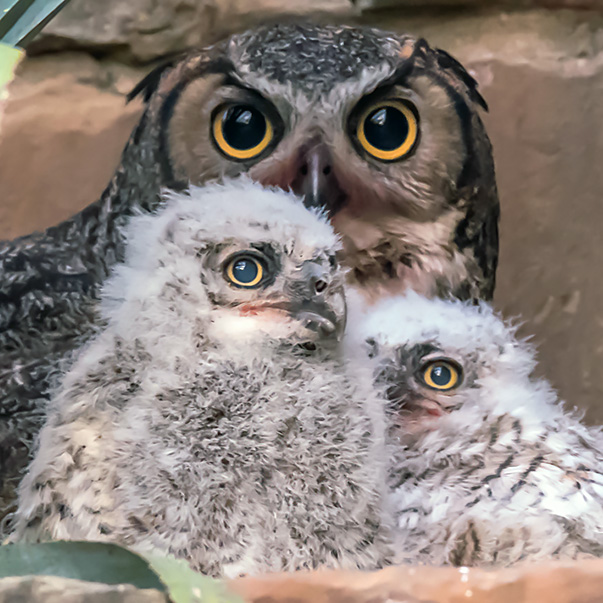Don't miss a thing!
Keep up-to-date on all the nesting news.
Video Highlights
-
Iris The Osprey Returns To Her Nest In Hellgate Canyon! – April 5, 2024
-
Bald Eagle Takes a Sip From an Icy Clark Fork River in Hellgate Canyon | January 14, 2024
-
Steller's Jay Drops By Hellgate Osprey Nest On Foggy November Afternoon – Nov. 1, 2023
-
Black-billed Magpie Drops By Hellgate Osprey Nest – July 24, 2023
News
-
April 10, 2024 Most Watched Nest Cam Highlights From Bird Cams!
-
November 4, 2019 Explore the New Bird Cams Website
-
October 3, 2019 Hellgate Osprey Cam Timeline
About the Hellgate Canyon Ospreys
This Osprey nest is at the mouth of the Hellgate Canyon near the edge of Missoula, Montana. It’s in a very busy location, right outside the Riverside Health Care Center and next to busy parking lots, a construction site, a busy highway, and a railroad. However, it’s also an ideal location in many ways, since these Ospreys have riverfront property only about 50 feet from the Clark Fork River. Being so close to people does not bother them, and hundreds of people enjoy watching them every day.
The female Osprey at this nest is called Iris because she has very distinctive spots on her iris, especially in her left eye. These iris patterns serve as individual barcodes and allow us to identify her. She has nested at this site for many years. Her mate of many years, Stanley, did not return in 2016, and she attempted to breed with a new male dubbed “Louis”, named after an influential local Salish elder named Louis Adams.

Ospreys are consummate fishing birds, and this pair fishes primarily from the Clark Fork River and nearby Rattlesnake Creek. They use their 6–7 foot wingspans to soar above the water, looking for fish, then diving as deep as 3 feet for shallow-swimming prey. Adult Ospreys usually weigh 3–4 pounds, and they can carry prey up to 50 percent of their own weight. Ospreys can live up to 25 years, and they typically lay 1–4 eggs in a clutch.
Most Osprey pairs are monogamous, staying paired across seasons and beginning nesting soon after each returns from a long migration. Both sexes incubate the eggs. The female sits for the majority of the time (including throughout the night) while the male provisions her with fish. After the eggs hatch, the male continues to bring fish to the nest; the female exclusively broods the young and dissects their meals for about a month after hatching. Later on, when the chicks no longer require her protection and their appetite for fish increases, she will leave the nest and go fishing.
The nest used to be on a power pole about 200 feet west of where it is now. This was dangerous, since the Ospreys could have been electrocuted, causing fires and power blackouts. In 2007, the current nest platform was erected to provide a safer place for the Ospreys to nest. They took to it immediately. Getting the new nest platform set up, and installing and running to high resolution camera for this feed for you to enjoy has been a large effort involving many groups: Riverside Health Care Center, Karen Wagner, Kate Davis and Raptors of the Rockies, Northwestern Energy, Dave Taylor Roofing Company, and Drs. Heiko Langner and Erick Greene of the University of Montana.
About The Montana Osprey Project
These Ospreys are an important part of a much larger project focusing on the health of aquatic systems and Osprey populations in western Montana. In collaboration with Rob Domenech (Director of the Raptor View Research Institute), Dr. Heiko Langner and Dr. Erick Greene started the Montana Osprey Project in 2007. They have been monitoring about 200 Osprey nests in western Montana.
Because of their top position in the food web, Ospreys are useful indicators of local environmental conditions. Young Ospreys eat only fish their parents catch within a few miles of the nest, so these young birds reflect the condition of the local fish population. And although many hawk species can be touchy—even dangerous—to work with, Ospreys make good subjects: they tolerate human activity well and they actually seek out human-made structures to use as nest platforms.
Osprey populations declined to near-extinction in the Lower 48 states after World War II as a consequence of exposure to DDT-based pesticides. The dwindling Osprey population helped trigger research into problems with DDT, resulting in its ban in the United States in 1972. Since then, Ospreys have returned to many large water bodies. Studies such as this one help scientists keep a watchful eye on how Ospreys—and the water bodies they depend on—are doing.
Since young Ospreys eat fish that their parents catch usually within a few miles of the nest, the young birds reflect the condition of the local water quality and fish. When the chicks are large enough to band, the researchers use a large bucket truck to get up to the nests. They take very small blood and feather samples from the chicks and put them quickly back in their nest. These samples are analyzed in Dr. Langner’s state-of-the-art environmental chemistry lab. The good news is that levels of some of the heavy metals of particular concern in western Montana (arsenic, lead, cadmium, zinc, and copper) occur at very low levels in the Osprey chicks. The bad news is that levels of mercury, a powerful neurotoxin, occurs in very high levels in Osprey chicks in some places. The Montana Osprey Project is now focusing on this serious environmental problem.
About Cams

The Cornell Lab Bird Cams connects viewers worldwide to the diverse and intimate world of birds. We work to make watching an active experience, sparking awareness and inspiration that can lead to conservation, education, and engagement with birds.
Our viewers tell us that watching the cams is a life changing experience: an unprecedented learning experience that they liken to virtual field trips or field biology in their living room. We’re excited to continue sharing and learning with the community as we watch the world of birds together.

Bird Cams is a free resource
providing a virtual window into the natural world
of birds and funded by donors like you
Pileated Woodpecker by Lin McGrew / Macaulay Library






















